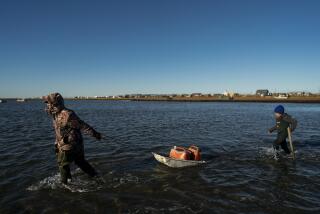Changing the Geography of Alaska
- Share via
JUNEAU, Alaska — Digital video compression, satellite broadcasting and other wonders of 1990s television technology seem oftentimes to be exclusively the concern of giant media conglomerates and their channel-hungry customers. But here in this sprawling state, these same technologies are being used to unite a widely scattered population and nurture an ever-fragile sense of statewide community.
For several years, the state has leased a single transponder on a communications satellite to send a single channel of television programming to villages that had no other video link to the outside world. At a cost of nearly $1 million a year for the transponder alone, it at least gave villagers a chance to see an eclectic mix of network news shows, sitcoms and ballgames.
But faced with dwindling oil revenues--the state’s chief source of funds--the Alaskan Legislature last year moved to cut back funding for the statewide network and at the same time severely reduce its contribution to the state’s four public television stations.
“Having the gun pointed at our head got us moving,” says Bill Legere, manager of Juneau’s public television station, KTOO.
With the help of a $1-million federal grant, the state put together an ambitious program to convert the statewide broadcast to digital signals, which can be compressed and transmitted more efficiently. The result is that Alaska now has the ability to broadcast several programs using the same transponder--and that has produced nothing less than a communications revolution.
Residents throughout the state--including some of its most remote communities--can now watch the Legislature on live television, potentially altering the delicate political dynamics of Alaska. And rural areas, known here as the bush, are now able to create their own programs for statewide distribution.
“It is changing the geography of Alaska,” says Mark Badger, director of information services for the state.
Digital satellite transmission technology is not completely new. It’s already being used by the fast-growing Hughes subsidiary DirecTv to offer households throughout the United States hundreds of TV channels via a special receiving dish. Terrestrial broadcasters are eventually expected to move to digital, enabling them to send either higher-resolution pictures or to transmit as many as six programs on the same frequency that now contains only one.
Alaska’s network, though, shows how the technology can accomplish a different set of goals.
The program is still in its infancy: About 243 receivers scattered around the state, which receive the signal from the satellite and then broadcast it over the air, are being equipped with digital decoders. State leaders believe that within a year the entire state will have access to multiple channels.
The technology has freed the state’s four public broadcasting stations to branch out into areas not considered feasible just a year ago.
The Fairbanks station now provides the PBS programming stream to stations in Juneau, the state’s capital, and Bethel, an isolated town in western Alaska. Since they no longer had to worry about the nuts and bolts of the daily PBS broadcast, employees of the Juneau station used their time to launch “Gavel to Gavel,” coverage of the Legislature, on another channel.
Badger believes the most important innovation resulting from the program may be the rural programming that now originates in Bethel. In the past, the state provided the television signal to the bush but offered no local programming. Now the bush has its own network, originating in Bethel.
“After being on the air for a couple of months, they linked Barrow [the northernmost community in America] and Bethel together to talk about alcohol in the villages,” Badger says. “That had never happened before.”
Of course, the local programming doesn’t look quite like that seen in urban centers in what Alaskans call “the lower 48.”
A few days ago, someone issued a decree that reporters and anchormen participating in the Bethel newscast would be required to wear ties. That evening, the anchorman wore a tie draped around the neck of a bright red sweatshirt.
Badger, who holds a doctorate in communications and anthropology from Cambridge University, believes giving the chiefly native bush country its own network will help preserve a culture that is rapidly disappearing.
“In Alaska, the whole trend is colonial. You’ve got one culture taking over another culture,” Badger says.
But local programming now gives the Eskimos and Indians of rural Alaska the tool to educate their people on the rich cultural traditions of their past, he adds.
“We wanted to show that these people will pick up the latest technology and really do something marvelously different,” Badger says. “And they did that.”
Lee Dye can be reached via e-mail at 72040.3515@compuserve.com
More to Read
Sign up for Essential California
The most important California stories and recommendations in your inbox every morning.
You may occasionally receive promotional content from the Los Angeles Times.













